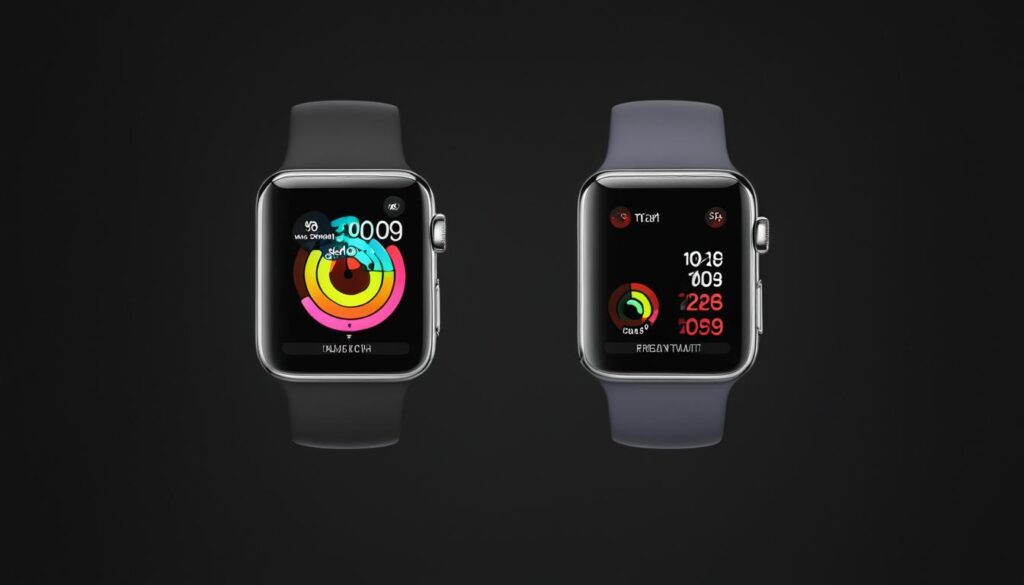The Apple Watch is a popular fitness tracking device that offers various features to help individuals monitor and improve their workouts. While it is commonly used for activities like running, cycling, and swimming, it can also be effectively utilized for traditional strength training sessions. Whether you are a seasoned weightlifter or a beginner looking to incorporate strength training into your routine, the Apple Watch can provide valuable insights and metrics to optimize your workouts.
While the Apple Watch’s Workout app does have a “Strength Training” option, it primarily focuses on tracking calories, time, and heart rate. However, there are alternative methods available to track specific details like reps, sets, and weight lifted. This article will explore how you can incorporate traditional strength training with your Apple Watch and maximize its benefits.
Key Takeaways:
- The Apple Watch can be effectively used for traditional strength training workouts, providing valuable insights and metrics.
- While the Workout app’s “Strength Training” option tracks general information, alternative methods can be used to track specific details like reps, sets, and weight lifted.
- By following guidelines, using Voice Memos or third-party apps, and choosing the right Apple Watch model, you can optimize your strength training experience.
- The Apple Watch offers features such as heart rate monitoring and goal setting to enhance your strength training workouts.
- Incorporating traditional strength training with the Apple Watch can help you track your progress and achieve your fitness goals effectively.
Benefits of Traditional Strength Training on Apple Watch
Traditional strength training offers numerous benefits that can significantly enhance your workouts when incorporated with the Apple Watch. Let’s explore the advantages of strength training and how the Apple Watch can help you achieve your fitness goals.
Building Muscle and Increasing Strength
Strength training is known for its ability to build muscle and increase strength. By engaging in exercises that target specific muscle groups, such as weightlifting or resistance training, you can stimulate muscle growth and improve overall strength levels. This results in a toned and sculpted physique.
Improving Bone Density
In addition to building muscle, strength training also contributes to improving bone density. As we age, our bones tend to weaken, increasing the risk of fractures and osteoporosis. By regularly engaging in weight-bearing exercises, strength training can help maintain or even increase bone density, keeping your skeletal system strong and healthy.
Boosting Metabolism and Fat Burning
Strength training has a significant impact on your metabolism. By increasing muscle mass, your body becomes more efficient at burning calories even at rest. This means that strength training can elevate your basal metabolic rate, helping you burn more calories throughout the day. Combined with proper nutrition, strength training can be an effective tool for weight management and fat loss.
Enhancing Overall Fitness
Strength training is not limited to physical appearance and strength gains. It also enhances overall fitness by improving cardiovascular health, increasing flexibility, and enhancing balance and coordination. By incorporating strength training into your routine, you can experience a well-rounded approach to fitness and improve your overall performance in various activities.
Tracking Progress and Setting Goals with Apple Watch
The Apple Watch provides a range of features that can enhance your strength training experience. With the ability to track your workouts, set goals, and monitor your heart rate, the Apple Watch offers real-time feedback and insights into your performance. This data-driven approach helps you stay accountable and make informed decisions about your training.
Creating Accountability and Motivation
The Apple Watch can help create a sense of accountability during your strength training sessions. With features like workout reminders and activity rings, the device encourages you to stay consistent and maintain an active lifestyle. Additionally, sharing your workout achievements with friends and participating in challenges can provide the motivation and support needed to reach your fitness goals.
Receiving Real-Time Feedback
During your strength training workouts, the Apple Watch provides real-time feedback on metrics like heart rate, calorie burn, and duration. This feedback allows you to make adjustments to your intensity and ensure you’re working at an appropriate level. It also helps you stay in the optimal heart rate zone for achieving your fitness goals.
Summary of Benefits
| Benefits of Traditional Strength Training with Apple Watch |
|---|
| Builds muscle and increases strength |
| Improves bone density |
| Boosts metabolism and fat burning |
| Enhances overall fitness |
| Tracks progress and sets goals |
| Creates accountability and motivation |
| Provides real-time feedback |
With its ability to track progress, offer real-time feedback, and enhance your motivation, the Apple Watch is an exceptional tool for incorporating traditional strength training into your fitness routine. Take advantage of the device’s features to optimize your workouts and achieve your fitness goals.
How to Incorporate Traditional Strength Training with Apple Watch

To incorporate traditional strength training with your Apple Watch, it’s important to follow some guidelines. First, choose the right workout type for your strength training session, such as “Functional Strength Training” or “Traditional Strength Training” in the Workout app. If the pre-set options don’t match your exercises, consider using Voice Memos or third-party apps like Fitbod, Gymaholic, or Strong to track your workouts and progress.
Make sure to wear your Apple Watch properly for accurate heart rate readings and consider calibrating your watch for better distance and pace measurements during outdoor activities.
Strength Training Guidelines for Apple Watch
When incorporating traditional strength training with your Apple Watch, there are some guidelines to keep in mind:
- Choose the appropriate workout type in the Workout app
- Utilize Voice Memos or third-party apps for detailed tracking
- Ensure proper Apple Watch placement for accurate heart rate readings
- Consider calibrating your watch for improved outdoor activity measurements
Traditional Weightlifting Exercises for Apple Watch
Traditional weightlifting exercises can be effectively tracked using your Apple Watch. Some common exercises include:
- Bench Press
- Squat
- Deadlift
- Shoulder Press
- Bicep Curls
- Tricep Extensions
- Lat Pulldowns
- Leg Press
By properly tracking these exercises, you can monitor your progress and ensure you are reaching your strength training goals.
Traditional Resistance Training on Apple Watch
Resistance training is an integral part of strength training. With your Apple Watch, you can monitor and track various resistance training exercises, such as:
| Exercise | Reps | Sets | Weight |
|---|---|---|---|
| Squats | 10 | 3 | 100 lbs |
| Bicep Curls | 12 | 3 | 30 lbs |
| Deadlifts | 8 | 4 | 200 lbs |
| Shoulder Press | 10 | 3 | 50 lbs |
| Tricep Extensions | 12 | 3 | 40 lbs |
Tracking these exercises and the associated reps, sets, and weight lifted allows you to analyze your progress and make adjustments to your training routine.
Using Voice Memos for Workout Tracking
If the Apple Watch’s Workout app doesn’t provide the tracking capabilities you need for strength training, you can use Voice Memos as an alternate method. Simply record your lifted totals during your workout and log your sets once you’re finished. Although this method requires more dedication to tracking and doesn’t offer immediate reference for past lifts, it provides a seamless and convenient way to collect workout data. Voice Memos can also be streamed to your iPhone for secure data storage and analysis.
For individuals who find the Apple Watch’s built-in features limited for tracking strength training exercises, using Voice Memos can bridge the gap and provide a viable solution. By utilizing the Voice Memos app on your Apple Watch, you can easily record the weights lifted during each set, making it simple to log your performance accurately.
While using Voice Memos requires a bit more effort and commitment to documenting your workout, it allows you to collect valuable data without the need for additional external devices or third-party applications. By leveraging this built-in feature, you have a convenient way to monitor and analyze your strength training sessions.
To make the most of Voice Memos for workout tracking on your Apple Watch, follow these steps:
- Access the Voice Memos app on your Apple Watch.
- Start a new recording at the beginning of your strength training session.
- Verbally state the weight lifted for each exercise and set.
- End the recording once you’ve completed your workout.
- Transfer the recorded Voice Memos to your iPhone for secure storage and analysis.
By keeping a detailed virtual log of your workout using Voice Memos, you can accurately record the weights you lift without relying solely on the limited tracking capabilities of the Apple Watch’s Workout app.
Using Voice Memos for workout tracking can be especially beneficial for individuals who prefer a more hands-on approach to monitoring their strength training progress. This method allows for flexibility and customization, ensuring that you capture accurate data for each and every workout.
Third-Party Apps for Strength Training on Apple Watch
If you prefer a more comprehensive tracking experience, there are several third-party apps available for strength training on the Apple Watch. Fitbod, Gymaholic, and Strong are recommended apps that can take your strength training to the next level.
These apps offer a range of features to enhance your workouts and provide valuable insights into your progress. Some of the key features include:
- Syncing with the Health app: These apps seamlessly integrate with the Health app on your iPhone, allowing you to keep all your fitness data in one place.
- Tracking lifts, reps, sets, calories, and heart rate: With these apps, you can track all the essential metrics of your strength training sessions, giving you a detailed overview of your performance.
- Workout recommendations: Fitbod, Gymaholic, and Strong provide personalized workout recommendations based on your fitness level, goals, and available equipment.
- Manual curation of workouts: You have the flexibility to customize and curate your workouts according to your preferences and specific training needs.
By using these third-party apps, you can not only track your workouts more effectively but also gain valuable insights into your training progress, helping you make informed decisions for future workouts.
Apple Watch Models for Strength Training

To make the most of your strength training with the Apple Watch, you’ll want a model that suits your athletic goals and tracking needs. The Apple Watch Ultra, Apple Watch Series 8, and Apple Watch SE are all suitable options. The Apple Watch Ultra is a premium choice with advanced tracking capabilities, while the Apple Watch Series 8 and SE offer a balance of features and affordability. Choose the model that fits your budget and desired tracking functionality.
When it comes to strength training, selecting the right Apple Watch model can enhance your workout experience. Whether you’re a professional athlete or simply looking to stay in shape, the right device can provide the necessary features and tracking capabilities to help you reach your goals.
The Apple Watch Ultra is the flagship model, offering cutting-edge technology and advanced features specifically designed for strength training. With its powerful processor and high-resolution display, it provides a seamless and responsive user experience. The Ultra also includes advanced fitness tracking sensors that can accurately measure your heart rate, track your workout intensity, and monitor your progress over time.
The Apple Watch Series 8 is a popular choice among fitness enthusiasts. It offers a good balance of features, performance, and affordability. With its built-in GPS, water resistance, and comprehensive fitness tracking capabilities, the Series 8 is well-suited for strength training activities. It also has a long battery life, ensuring that it can keep up with your demanding workout sessions.
If you’re looking for a more budget-friendly option, the Apple Watch SE is worth considering. It provides many of the essential features you need for strength training, including heart rate monitoring, workout tracking, and compatibility with third-party fitness apps. While it may not have all the advanced features of the Ultra or the Series 8, the SE offers excellent value for money.
Ultimately, the choice of Apple Watch model for strength training depends on your personal preferences, budget, and the specific features you prioritize. Consider your fitness goals, the level of detail you want in tracking your workouts, and any specific requirements you may have. With the right Apple Watch model, you can optimize your strength training routine and take your fitness journey to new heights.
How Can Apple Watch Help in Optimizing Strength Training?
The functional strength training on Apple Watch offers personalized workout tracking, allowing users to set specific goals and track progress. By monitoring heart rate, calories burned, and providing real-time feedback, Apple Watch helps optimize strength training workouts for maximum results.
Tips for Optimal Strength Training with Apple Watch
To optimize your strength training with the Apple Watch, there are a few tips to keep in mind. First, ensure that your Apple Watch fits properly on your wrist for accurate heart rate readings. Tighten it during workouts and loosen it afterward for comfort.
Also, consider using Bluetooth chest straps for more reliable heart rate measurements, especially during high-intensity exercises. These straps can provide a more accurate and continuous heart rate tracking experience, allowing you to gauge your effort level and optimize your training intensity.
Additionally, take advantage of the Apple Watch’s workout settings. For longer training sessions, enable Low Power Mode to conserve battery life. This way, you can track your entire workout without worrying about the watch’s battery running out.
Furthermore, don’t forget to sync your favorite workout playlists or podcasts to your Apple Watch. This feature allows for a more enjoyable and immersive workout experience, motivating you to push harder and stay focused during your strength training sessions.
Conclusion
In conclusion, the Apple Watch is an exceptional fitness tracker that can revolutionize your traditional strength training workouts. With its comprehensive features and user-friendly interface, it provides a seamless experience for tracking your progress and achieving your fitness goals.
By following the provided guidelines, you can ensure that your Apple Watch accurately captures the data you need, whether through the Workout app, Voice Memos, or third-party apps. This allows you to monitor your reps, sets, and weight lifted, providing valuable insights into your performance.
Furthermore, the Apple Watch’s ability to monitor your heart rate and set personalized goals helps you optimize your strength training routine and push yourself to the next level. Whether you’re a fitness enthusiast or a professional athlete, the Apple Watch is a reliable companion that can enhance your traditional strength training sessions.
Source Links
- https://www.gearpatrol.com/fitness/a40679324/apple-watch-strength-training/
- https://support.apple.com/en-sa/105089
- https://support.apple.com/en-us/105002




